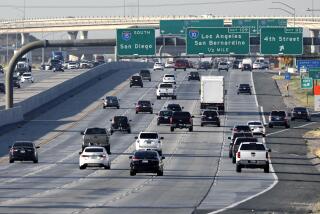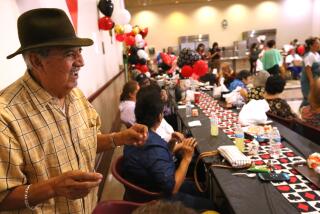Commutes Slightly Shorter, Survey Finds : Transit: More Southern Californians drove alone to work in 1992, but time in their cars decreased.
Although more Southern Californians drove alone to work last year, their commutes were slightly shorter and they spent less time in their cars, according to a five-county study released Tuesday.
Fully 79% of those surveyed drove alone to work in 1992, a 2% increase from the previous year, and fewer people rode the bus or walked to work, according to the nonprofit Commuter Transportation Services Inc. in its fifth annual State of the Commute. Yet one of five behind the wheel said they believed their commute had improved.
Experts say the recession and high unemployment removed many cars from the freeways, and a decrease in employer-offered incentives for ride-sharing prompted more people to drive alone.
As much as Southern Californians like to complain about their commute, precious minutes and miles have been shaved from the trips to work. In 1992, the average driver traveled 33 minutes to arrive at a workplace that was generally about 29.6 miles from home. The previous year, the average commute was 36 minutes and 33.2 miles. The 1992 figures represent the first decrease in travel distance in five years.
“For the first time, a majority of freeway commuters we surveyed (51%) said they thought freeway traffic was better than or the same as it had been the previous year,” said Jim Sims, president of CTSI, a private group underwritten partially by Caltrans that promotes alternative methods of commuting.
The trend toward driving alone reflects a longtime pattern occurring nationwide, some experts say.
“There’s an overall historical increase in driving alone that’s been going on for decades, that’s partly due to rising incomes and decentralization or shifts in where jobs are,” said Genevieve Guiliano, an associate professor at the USC School of Urban and Regional Planning. “Those are very long-term trends.”
The study of commuter habits is based on a telephone survey of 2,591 residents in Los Angeles, Orange, Riverside, San Bernardino and Ventura counties. It was conducted from October to December of 1992, before Caltrans officials launched an ambitious $4-million ad campaign encouraging people to share rides to work once a week.
The $50,000 study was funded by Caltrans, the Metropolitan Transportation Authority and the Department of Transportation.
According to the study, 15% of Southern Californians used car-pools in 1992, 3% rode the bus, and 1% each van-pooled, walked or biked to work. In 1991, 14% car-pooled, 5% rode the bus, 1% van-pooled or bicycled and 2% walked.
At small companies, according to the survey, fewer people--47% compared to 65% the previous year--were aware of any ride-share incentives. At large work sites, which are subject to air quality regulations and are required to offer ride-sharing incentives, the number of workers aware of the programs decreased 90% to 84% from the previous year.
Even though fewer people were aware of ride-share efforts, more said they would be willing to try it. Of those surveyed, 42% said they would be willing to car-pool.
The study also showed:
* 76% drive alone in L.A. County; 86% in Orange County; 85% in Riverside; 80% in San Bernardino; 82% in Ventura.
* Riverside County residents spend the most time commuting (80 minutes round trip) and travel the longest distance (45.6 miles round trip).
* Nearly 20% of commuters who changed jobs during the last two years attributed their moves to commute-related issues.
* Men, on average, drive eight miles farther than women during their commute (34 miles to 26), traveling an additional nine minutes (73 minutes to 64).
* 20% of new ride-sharers cited cost savings as a reason for car-pooling.
* Roughly one-third of all commuters working in Orange County said they were bothered by congestion. In L.A., 39% did. In Ventura County, the fewest--18%--said congestion was a problem.
More to Read
Sign up for Essential California
The most important California stories and recommendations in your inbox every morning.
You may occasionally receive promotional content from the Los Angeles Times.










